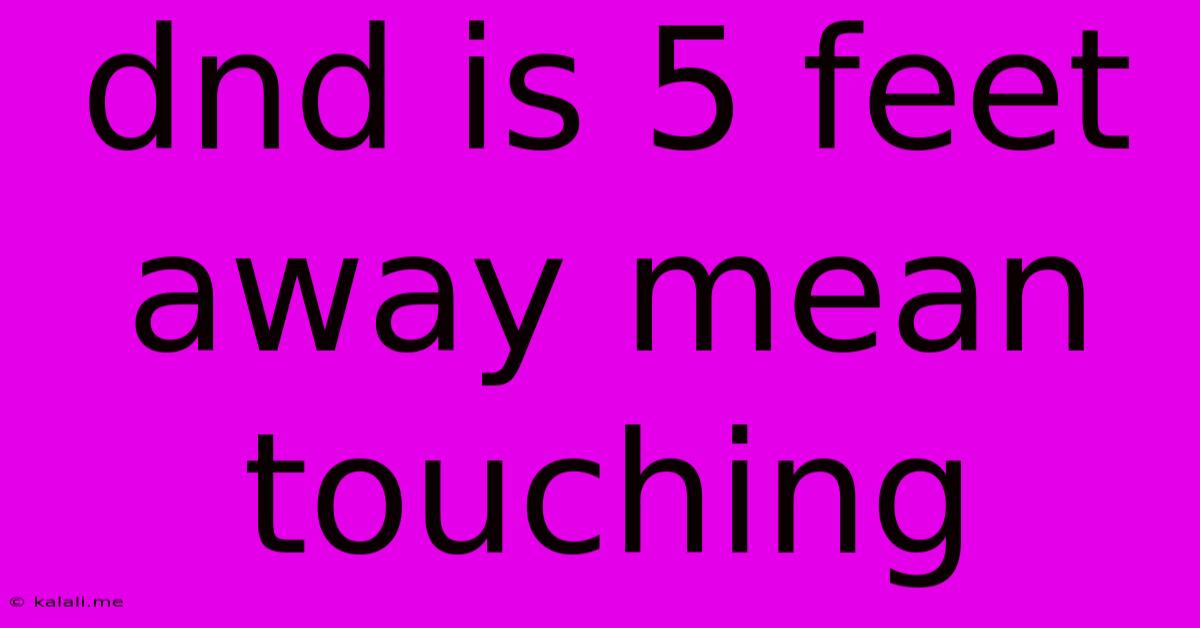Dnd Is 5 Feet Away Mean Touching
Kalali
Jun 01, 2025 · 3 min read

Table of Contents
D&D's 5-Foot Rule: Are You Touching or Not?
So, you're playing Dungeons & Dragons, and the rules mention a "5-foot reach." Does that mean you're literally touching the creature, or is there a bit more wiggle room? This seemingly simple question has led to many a debate around the table, and understanding the nuances is crucial for smooth gameplay and avoiding frustrating rulings. This article clarifies the meaning of a 5-foot reach in D&D, exploring its implications for various actions and spells. We'll dispel some common misconceptions and offer practical advice for handling this frequently asked question.
The simple answer is: a 5-foot reach in D&D means you are close enough to touch the target, but not necessarily touching them. Think of it as your effective striking distance, not necessarily a literal embrace.
Understanding Reach and its Implications
The 5-foot reach is primarily determined by your size and the weapon you're using. A human with an unarmed strike has a 5-foot reach, meaning they can strike anything within that 5-foot radius. This is different from a melee weapon's reach, which can extend your striking distance. A halberd, for example, will extend your effective reach. This means you could attack a target further than 5 feet away while still being within the reach of your weapon.
Consider these scenarios:
- Unarmed Strike: You're within 5 feet of a goblin. You can attack. You're not necessarily touching it, but close enough to punch or kick.
- Melee Weapon: You have a longsword, granting you a 5-foot reach. You're able to strike a target 5 feet away. Again, you might not be touching, but the sword's reach allows you to connect.
- Spells: Some spells specify a range, often in feet. If a spell requires a touch, the target must be within your reach (including any reach granted by a weapon or spell).
- Grappling: Grappling requires being within 5 feet of a creature and succeeding on a Strength (Athletics) check. Once you grapple a creature, you are considered to be in contact. This is an exception where being within 5 feet translates to physical contact.
Common Misconceptions and Clarifications
- 5 feet is always touching: Incorrect. It's the effective range for attacks and other actions, allowing for a margin of space.
- You need to be adjacent to attack: This is only true for melee attacks with no reach. If you have a 5-foot reach (or more), you can attack from up to that distance without being adjacent. Adjacency is often relevant to other interactions.
- All spells with a 5-foot range are touch spells: Incorrect. Many spells have a range, but aren't necessarily touch spells. Touch spells specifically state they require physical contact.
Practical Tips for Game Masters and Players
- Use miniatures and grid: Visually representing the battlefield on a grid clarifies the 5-foot distances.
- Establish clear communication: When in doubt, talk to your DM. Explain the situation and work towards a solution together.
- Refer to the Player's Handbook: The PHB provides rules for reach and other combat interactions. Always refer back to the official rules for clarification.
- Consider situational context: A cramped space might mean 5 feet does indeed result in touching. An open field will provide more space within that 5-foot distance.
The 5-foot reach in D&D isn't about the literal act of touching but about the effective distance for various actions. Understanding this distinction helps ensure fair and smooth gameplay, enhancing the overall enjoyment of your Dungeons & Dragons experience. By correctly interpreting this fundamental aspect of the game, you can avoid misunderstandings and focus on more strategic aspects of your campaign.
Latest Posts
Latest Posts
-
Should Yesterday Go At The End Or
Jun 02, 2025
-
How Much Is A Half Of Pound
Jun 02, 2025
-
A Or An Before An Abbreviation
Jun 02, 2025
-
How To Get Smell Of Gas Off Hands
Jun 02, 2025
-
Leaving After A Week Better Job Offer
Jun 02, 2025
Related Post
Thank you for visiting our website which covers about Dnd Is 5 Feet Away Mean Touching . We hope the information provided has been useful to you. Feel free to contact us if you have any questions or need further assistance. See you next time and don't miss to bookmark.